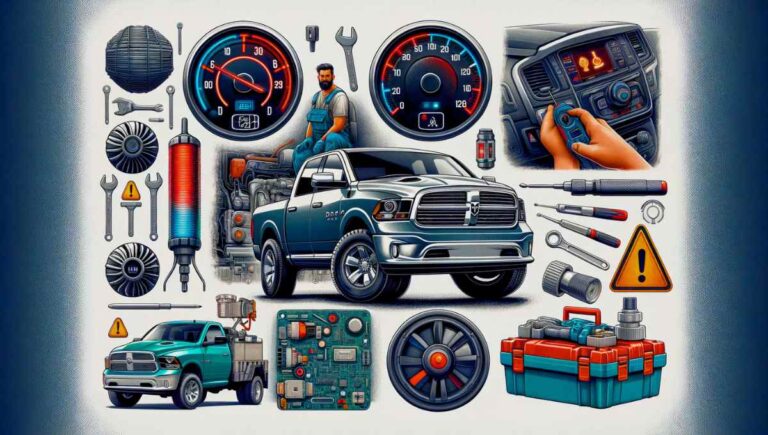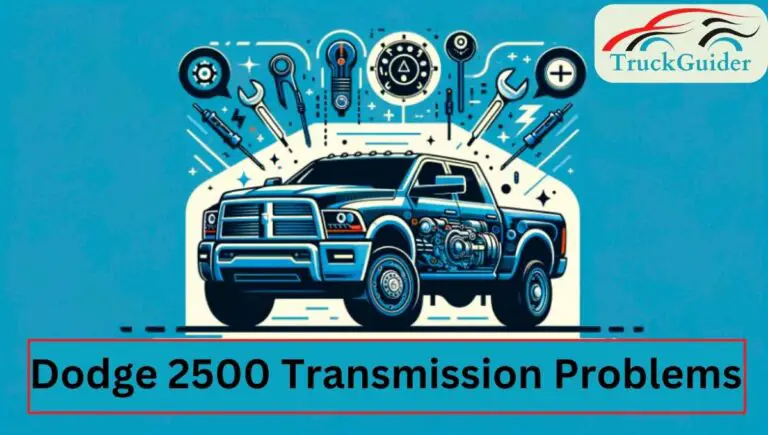2018 Ram 2500 ABS And Traction Control Light: Must-Knows
Are you noticing warning lights for the ABS and traction control on your 2018 Ram 2500? You’re not alone, and it’s crucial to address these issues for safe driving. In this guide, we’ll cover:
- Common problems with the ABS and traction control systems
- Steps to diagnose and fix these issues
- How to maintain these vital safety features
- Guidelines for disabling and re-enabling the systems, if necessary
Stay tuned to keep your truck running smoothly and safely.
Common Problems with ABS and Traction Control Systems
Understanding the issues that can arise with ABS and traction control systems in your 2018 Ram 2500 can save you time and stress. Here’s an in-depth look at the usual suspects.
Wheel Speed Sensor Problems
Wheel speed sensors play a crucial role in the functioning of both ABS and traction control systems. When they falter, you’ll notice.
Symptoms
- Warning lights: ABS or traction control warning lights illuminate.
- Reduced functionality: Systems don’t engage when needed.
- Braking issues: Your vehicle may pull to one side while braking.
Causes
- Sensor damage: Physical damage to the sensor.
- Dirt accumulation: Mud or dust obstructing the sensor.
- Wire issues: Damaged or disconnected wiring.
Solutions
- Sensor Cleaning: A simple cleanup might solve the issue.
- Sensor Replacement: Sometimes, the only option is to install a new sensor.
- Wiring Fix: Reconnecting or replacing damaged wires.
ABS Module Problems
The ABS module is like the brain of your ABS system. If it fails, your ABS doesn’t stand a chance.
Symptoms
- Warning lights: ABS or traction control lights turn on.
- Lack of engagement: The ABS system won’t kick in when required.
- Lock-up: Brakes may lock during braking.
Causes
- Software glitches: Outdated or corrupt software.
- Electrical failure: Shorts or disconnections in the module.
- Physical damage: Impact or wear and tear affecting the module.
Solutions
- Software Update: Sometimes, a quick update is all that’s needed.
- Electrical Repair: Fixing any shorts or disconnections.
- Module Replacement: In extreme cases, a new ABS module may be necessary.
Traction Control Solenoid Problems
The traction control solenoid controls the distribution of power to the wheels. If it fails, maintaining control of your vehicle becomes much harder.
Symptoms
- Warning lights: The familiar ABS or traction control warning lights will show up.
- Skidding: Wheels may spin out during acceleration.
- Loss of control: Traction control won’t engage, making the vehicle hard to manage.
Causes
- Electrical Issues: Wiring faults leading to the solenoid.
- Mechanical Failure: Wear and tear or physical damage.
- Overheating: Prolonged use leading to solenoid failure.
Solutions
- Wiring Repair: Fixing any disconnected or damaged wires.
- Solenoid Replacement: A new solenoid might be the best solution.
- Cooling Measures: Installing additional cooling to prevent overheating.
How to Diagnose ABS and Traction Control Problems
Before you can fix any issues with your ABS and traction control systems, you first need to identify what’s going wrong. Here’s how to go about diagnosing problems effectively.
Checking Warning Lights
When something’s not right, your vehicle will usually let you know through warning lights on the dashboard.
- ABS Light: Indicates a problem with the Anti-lock Braking System.
- Traction Control Light: Suggests that the traction control system needs attention.
Action Steps:
- Check your vehicle manual to identify warning light symbols.
- Take note of any patterns, like blinking or color changes.
Scanning for Trouble Codes
A more precise diagnosis can be made by scanning for trouble codes using a specialized tool.
How to Use a Code Scanner
Using a code scanner is generally straightforward and can provide valuable insights.
- Connect the Scanner: Plug the scanner into the OBD-II port, usually located under the dashboard.
- Run the Scan: Follow the on-screen instructions to scan the vehicle for trouble codes.
- Record Codes: Make note of any codes that appear and look them up for specific issues.
Inspecting Wheel Speed Sensors
Wheel speed sensors are crucial for both ABS and traction control systems to function properly.
Locations and Identification
Wheel speed sensors are typically located near each wheel.
- Front Wheels: Often found near the brake rotors.
- Rear Wheels: Usually near the rear brake components.
Action Steps:
- Refer to the vehicle manual for exact locations.
- Identify sensors by their small, cylindrical shape and wiring.
What to Look for
Inspect the wheel speed sensors for common issues.
- Physical Damage: Cracks, chips, or obvious signs of wear.
- Dirt and Debris: Clean off any mud, dirt, or debris that could obstruct the sensor.
- Wire Condition: Check for frayed wires or loose connections.
Inspecting the ABS Module
The ABS module acts as the control center for the ABS system. A faulty module can lead to system-wide issues.
Locations and Identification
The ABS module is usually located in the engine compartment.
- Location: Often near the master cylinder or firewall.
- Identification: A metal box with multiple wire connections.
Action Steps:
- Refer to your vehicle’s manual for specific location details.
- Look for a metal box with several wire connections.
What to Look for
During inspection, pay close attention to these elements.
- Physical Condition: Look for signs of damage or corrosion.
- Wiring: Inspect for loose connections or frayed wires.
- Error Codes: Some ABS modules have LED indicators that flash error codes.
By following these steps, you’ll have a strong foundation for identifying any issues with the ABS and traction control systems on your 2018 Ram 2500. This will make resolving those issues much more straightforward.
How to Repair ABS and Traction Control Problems
After diagnosing issues with your ABS and traction control systems, the next logical step is to tackle the repairs. Below are detailed guidelines to help you resolve specific problems.
Replacing Wheel Speed Sensor
If diagnostics point to a malfunctioning wheel speed sensor, replacing it is often the best course of action.
Steps for Replacement
- Gather Necessary Tools: Collect essential tools like a car jack, lug wrench, socket set, and gloves for safe handling.
- Safety First: Ensure your vehicle is on a flat surface. Engage the parking brake for added safety.
- Lift the Affected Wheel: Use the car jack to lift the corner of the vehicle where the faulty sensor is located.
- Wheel Removal: Use a lug wrench to loosen the lug nuts before removing the wheel to expose the wheel hub and sensor.
- Identify the Sensor: The wheel speed sensor is usually mounted near the brake rotor. It’s a small cylindrical object connected to the vehicle’s electrical system.
- Disconnect the Sensor: Carefully disconnect the electrical connector attached to the sensor. You may need to press a release tab to pull it out.
- Unbolt and Remove the Sensor: Using the appropriate socket from your socket set, remove the bolts that secure the sensor to the wheel hub.
- Install the New Sensor: Position the new sensor in place and hand-tighten the bolts initially to ensure proper alignment.
- Tighten the Bolts: Use your socket set to securely tighten the bolts.
- Reconnect Electrical Connector: Attach the electrical connector back into the new sensor. Make sure it clicks into place.
- Replace the Wheel and Lower Vehicle: Put the wheel back onto the hub, tighten the lug nuts, and carefully lower the vehicle using the jack.
- Test: After everything is secure, take a short drive to ensure that the warning lights have turned off and the systems function as expected.
Repairing or Replacing ABS Module
Issues with the ABS module can cause your entire ABS system to fail, warranting immediate attention.
Steps for Repair or Replacement
- Safety Measures: Make sure the vehicle is off, and the keys are removed from the ignition.
- Disconnect the Battery: Open the hood and disconnect the negative battery cable to prevent any electrical mishaps.
- Locate the ABS Module: Generally, the ABS module is located in the engine compartment, often near the firewall or close to the master brake cylinder.
- Label and Disconnect Electrical Wires: Before disconnecting, label each wire or take photos for reference. Then, carefully unplug all electrical connectors.
- Unbolt the Module: Use your socket set to remove all bolts or fasteners holding the ABS module in place.
- Examine the Module: Check for any obvious signs of damage, wear, or loose connections that can be repaired.
- Decision Time: Decide whether to repair the existing module or replace it with a new one based on your inspection.
- Install or Re-install Module: Either repair and re-install the existing module or place the new one in the same location.
- Secure the Module: Use the socket set to tighten all bolts or fasteners securely.
- Reconnect Electrical Wires: Refer to your labels or photos and reconnect all electrical wires to the module.
- Battery Reconnection: Reconnect the negative battery cable and tighten it securely.
- System Check: Turn on your vehicle and check for any warning lights. Test drive to ensure the ABS and traction control systems are functioning correctly.
By adhering to these detailed steps, you should be well-equipped to resolve most common issues related to the ABS and traction control systems in your 2018 Ram 2500. If you’re unsure about any steps or encounter complications, it’s recommended to seek professional assistance.
How to Bleed the ABS System
After repairing or replacing components in your ABS system, you’ll often need to bleed the system to remove any trapped air. Air in the system can reduce braking efficiency, so it’s crucial to complete this step.
Tools Required
Before you begin, make sure you have all the necessary tools and supplies:
- Brake fluid (Check your vehicle manual for the specific type)
- Clear plastic tubing
- Wrench set
- Pressure bleeder
- Catch container for old fluid
- Gloves and safety goggles for protection
15 Steps to Follow to Bleed the ABS System
Follow these steps to effectively bleed your ABS system:
- Safety Measures: Park your vehicle on a level surface and engage the parking brake.
- Preparation: Put on your gloves and safety goggles to protect yourself from brake fluid, which can be corrosive.
- Locate Brake Fluid Reservoir: Open the hood and locate the brake fluid reservoir, usually near the master cylinder.
- Connect Pressure Bleeder: Attach a pressure bleeder to the brake fluid reservoir. This will help push the fluid and any air out.
- Check Fluid Levels: Make sure the brake fluid reservoir is full. You’ll be adding fluid as you go, so keep the bottle handy.
- Locate Bleeder Screws: These are generally located on the brake calipers at each wheel. Start with the wheel farthest from the master cylinder, usually the rear passenger side.
- Attach Tubing: Attach a piece of clear plastic tubing to the bleeder screw and place the other end in a catch container.
- Open Bleeder Screw: Use a wrench to open the bleeder screw. Monitor the tubing for brake fluid and air bubbles.
- Activate Pressure Bleeder: Activate the pressure bleeder to push new brake fluid through the system, forcing out the old fluid and any trapped air.
- Monitor Fluid: Keep an eye on the brake fluid level in the reservoir, adding more as needed to prevent it from getting too low, which could introduce more air into the system.
- Check for Air Bubbles: Continue the bleeding process until no more air bubbles appear in the tubing.
- Tighten Bleeder Screw: Once all air is removed, use a wrench to tighten the bleeder screw back into place.
- Move to Next Wheel: Repeat steps 6-12 for each wheel, moving closer to the master cylinder each time.
- Final Check: After all wheels have been bled, do a final check to make sure the brake fluid is at the appropriate level in the reservoir.
- Test Drive: Take a cautious test drive to make sure the brakes are functioning correctly. If the brake pedal feels spongy, you may need to repeat the bleeding process.
By following these detailed steps, you should successfully bleed the ABS system, ensuring optimal braking performance.
Testing the Repaired ABS and Traction Control Systems
Once repairs are done, it’s crucial to test the systems to confirm they’re working as expected. Here’s how to do it safely and effectively.
How to Test the ABS System Effectively
- Find a Safe Testing Area: Look for an empty parking lot or similar open area.
- Accelerate Then Brake: Speed up to about 20-25 mph, then firmly apply the brakes.
- Feel for ABS Activation: The brake pedal should pulse, and you should not skid. If you do, it indicates a problem.
Note: Perform this test several times to ensure consistent results.
Safety Precautions During Testing
- Use Safety Gear: Always wear your seatbelt during testing.
- Clear Area: Make sure there are no pedestrians or other vehicles nearby.
- Daytime Testing: Conduct tests in daylight to increase visibility.
Maintaining Your ABS and Traction Control Systems
Ongoing maintenance is the key to long-term reliability of your ABS and traction control systems.
Inspecting for Corrosion and Damage
Regular inspections can help catch issues before they become major problems.
Wheel Speed Sensors
- Visual Inspection: Look for visible damage or corrosion.
- Wire Check: Make sure the wires connected to the sensors are in good condition.
ABS Module
- Examine for Rust: Given its location, the ABS module is susceptible to rust.
- Check Connections: Ensure all electrical connections are secure and free from corrosion.
Replacing Brake Fluid
Consistent brake fluid quality ensures optimal performance.
Frequency and Importance
- Frequency: Every 2 years or as per manufacturer’s guidelines.
- Importance: Old or contaminated fluid can impair system function.
Flushing the ABS System
Flushing removes any contaminants and can improve system longevity.
When and Why to Flush
- When: Every 3 years or following major brake service.
- Why: To remove debris and prevent blockages in the hydraulic unit.
Additional Maintenance Tips
- Avoid Deep Water: Prolonged exposure to water can damage sensors.
- Qualified Checks: Have regular inspections by a qualified mechanic to catch issues early.
How to Disable and Re-enable ABS or Traction Control Systems
There might be instances where you find the need to disable your ABS or traction control systems temporarily. Here’s a guide on how to do it safely, along with precautions to consider.
Disclaimer
Caution: Disabling the ABS or traction control systems is generally not recommended, as these are important safety features. Always consult your vehicle’s manual and consider professional advice before proceeding.
General Steps to Disable
Disabling these systems usually involves removing a specific fuse from the fuse box.
Finding the Fuse Box
- Under the Hood: The fuse box is often located under the hood near the battery.
- Interior Options: Some models have an additional fuse box inside the vehicle.
Identifying and Removing the Fuse
- Owner’s Manual: Use your vehicle’s manual to identify the fuse corresponding to the ABS or traction control system.
- Fuse Puller or Pliers: Use a fuse puller or pliers to carefully remove the identified fuse.
General Steps to Re-enable
Re-enabling is almost the reverse of disabling, with an extra step for safety.
Reinstalling the Fuse
- Insert the Fuse: Place the fuse back in its designated slot in the fuse box.
- Check Connections: Make sure it’s seated properly and the metal leads are visible.
- Start the Vehicle: Turn on the ignition to verify that the system is active again.
Taking care of your 2018 Ram 2500’s ABS and traction control systems is like giving your truck a safety shield. This guide walks you through repairs, testing, and upkeep so you can hit the road with peace of mind. When in doubt, always turn to the pros. Safe travels!






